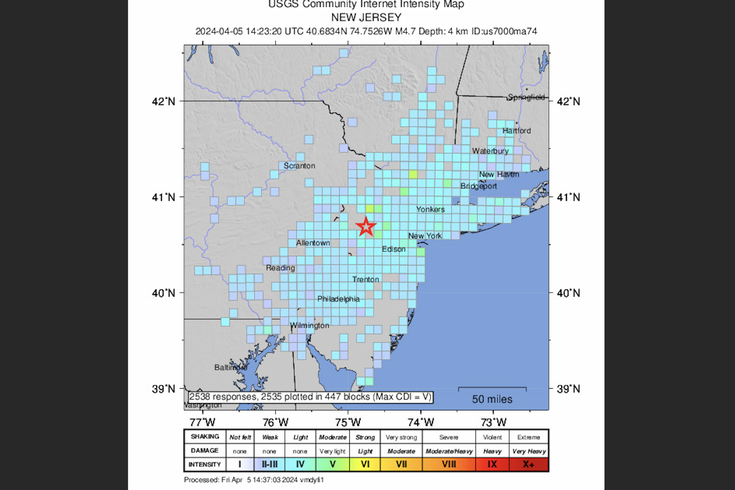
April 05, 2024
 @NWS_MountHolly/X, formerly Twitter
@NWS_MountHolly/X, formerly Twitter
This map shows the details of the earthquake felt across the Philadelphia region and beyond on Friday, April 5, 2024. According to the U.S. Geological Survey, the earthquake measured 4.7 near Califon, New Jersey.
People throughout the Philadelphia region felt their homes and office buildings rumble Friday morning due to an earthquake centered near Califon, New Jersey. The Hunterdon County borough is about 70 miles north of Philly.
The earthquake had a preliminary magnitude of 4.8, the U.S. Geological Survey said. The USGS initially reported that the quake occurred near Whitehouse Station at 10:23 a.m., but later amended the location. As of 1:40 p.m., no significant damage tied to the earthquake has been reported in the Philadelphia region.
Preliminary data released by USGC indicates the earthquake had a depth of 4.7 kilometers — about 3 miles — putting it in the shallow range of such events. The instruments used to measure the magnitude of earthquakes put it at the upper end of the "light" range, which causes "noticeable shaking of indoor objects and rattling noises" but does not typically result in much damage, if any.
Notable quake, preliminary info: M4.8 - 7 km N of Whitehouse Station, New Jersey https://t.co/SE99SKwosw https://t.co/ADcDLsTp8b pic.twitter.com/9Q9UvhogCP
— USGS Earthquakes (@USGS_Quakes) April 5, 2024
The earthquake was felt widely from Maine to Washington, D.C., according to the USGS, which based that info on community reports. People who felt the quake can share their experiences with the USGS on this form.
Jonathan Nyquist, a professor of earth and environmental science at Temple University, said East Coast earthquakes are not unusual, but they tend to be smaller than Friday's quake.
"It's not the biggest the East Coast ever felt, that's for sure," Nyquist said. "But it's just not common that we get one that people feel all the way from New York down to here.
"But that's in part because the crust in the eastern part of the United States is older and colder, and the faults are more healed than out in the western part of the (country). So the crust tends to ring like a bell here. The feelings of a small quake are felt over a larger area than maybe felt in some place like California."
MORE: Live broadcasts, home videos capture earthquake confusion by people and pets
The New Jersey Geological & Water Survey, the agency responsible for monitoring seismic activity, reported that Friday's earthquake did not surpass the strongest ever recorded in the state: a 5.3-magnitude quake that struck in Rockaway Township, Morris County in 1783.
About an hour after the initial earthquake, at 11:20 a.m., the USGS recorded a much weaker 2.0-magnitude tremor 4.3 miles west of Bedminster, New Jersey. That location is not far from where the initial earthquake originated. Then around 6 p.m., a stronger 4.0-magnitude tremor was recorded in the area of Gladstone, New Jersey — also nearby Friday morning's earthquake.
Notable quake, preliminary info: M 4.0 - 7 km SW of Gladstone, New Jersey https://t.co/0tzbU76PGe
— USGS Earthquakes (@USGS_Quakes) April 5, 2024
The USGS aftershock forecast said there is the potential for at least one aftershock during the next week, though any aftershocks are likely to be much weaker than the earthquake on Friday morning and would be contained to a several-mile radius around the epicenter in North Jersey.
Nyquist said the initial quake likely was not large enough to produce aftershocks that many people will feel – an assessment supported by the USGS aftershock forecast. The late afternoon tremor on Friday could be felt in Philadelphia and other parts of the region, according to reports received by the USGS.
"If you have a really big quake, like 6, 7 or 8, something like that, then aftershocks are guaranteed," Nyquist said. "It's like crinkling up wrapping paper and then letting your hand go."
MORE: Philly bans license plate flippers, which allow drivers to evade tolls, parking tickets and police
According to the USGS, there is a 3% chance that a subsequent tremors could register a magnitude greater than 5. In total, the USGS predicts there could be as many as 27 aftershocks with 3-magnitudes or greater, which would be strong enough to be felt near where they originated but unlikely to cause much damage.
There is a 45% chance of a 3-magnitude aftershock during the next week, and there is a 0.3% chance a subsequent quake will register more than a 6-magnitude, the agency said. The USGS aftershock forecast changes over time, particularly during the 72 hours after the first earthquake. This is because aftershocks decrease as time goes on, but also strong aftershocks can trigger more seismic activity and result in additional aftershocks.
In the event of more aftershocks, people should stay inside, according to Dominick Mireles, director of the city's Office of Emergency Management. Staying indoors protects people from dangerous debris, falling trees, downed power lines and crumbling buildings. Compared to the earthquake in 2011, fewer people rushed outside on Friday, he said.
The largest earthquake to be felt in Philadelphia in recent memory was in 2011, when a 5.8 magnitude quake centered outside Richmond, Virginia sent tremors through the city and was felt from Georgia to Canada. More recently, a 4.1-magnitude earthquake occurred in 2017 at a coastal site along the Delaware Bay, about 53 miles south of Philly, and was widely felt in the Mid-Atlantic region and the Northeast.
Still, Friday's earthquake was large enough to fuel reactions across the region. Some people reported feeling the ground shake for varying amounts of time.
"It depends on the ground below your house," said David Wunsch, Delaware's state geologist and a professor at the University of Delaware. "If your foundation is on or pretty close to the solid bedrock, that energy is going to transfer a lot more efficiently and it might shake for a lot longer. But if your house is built on sand or the rocks below ground are not solidified, that kind of filters that energy. It depends on the construction of your house, too."
Though earthquakes aren't uncommon in the Northeast, Wunsch said their frequency is best understood when thinking in geological time.
"The earth is an active planet and large plates of the earth's crust are moving around," he said. "Most of these crustal plates are moving about the rate of our fingernail growth — a couple centimeters per year. But over thousands of years, it equates to a significant amount of movement and that stress builds up."
The earthquake in New Jersey happened two days after a 7.2-magnitude earthquake hit Taiwan, killing at least 12 people and leaving hundreds more trapped and injured. It was the biggest earthquake to hit the island in 25 years. It caused extensive damage to Taiwan's infrastructure and sent tremors through the region — including a tsunami in Japan. The rescue effort in Taiwan continued amid multiple aftershocks as first responders braved the threat of landslides.
Wunsch said there's no basis to assume the earthquake in Taiwan is connected to the one in New Jersey.
"I don't think there's ever been any really good scientific studies that document that one big event spurs on other ones, especially around the globe," he said. "There will be more research on that. We learn new things all the time as we get better sensitive instruments and satellites that register gravity at very small levels. You never know, we may find correlations like that."
The USGS is still collecting data to determine more exact measurements of Friday's earthquake. Nyquist, who is not part of the USGS, said the exact magnitude likely will be determined by the end of the day.
"There's a whole bunch of seismic monitors all around the place and they all feel at different distances and they use that to triangulate that to get a source," Nyquist said. "And then they come up with an instant solution for roughly estimating the magnitude, but it takes a while for them to go back and check the records and come up with the final number."
State and local officials were quick to post information on Friday's earthquake – in some cases even before the USGS confirmed the quake.
A 4.8 magnitude earthquake hit New Jersey and was felt in parts of Pennsylvania.
— Governor Josh Shapiro (@GovernorShapiro) April 5, 2024
My team and @PEMAHQ are actively monitoring the situation and in contact with counties on any damage. We will keep Pennsylvanians updated.
Rail service system-wide is subject to up to 20-minute delays in both directions due to bridge inspections following an earlier earthquake.
— NJ TRANSIT (@NJTRANSIT) April 5, 2024
A 4.8 magnitude earthquake in New Jersey may impact some air traffic facilities in New York, New Jersey, Philadelphia and Baltimore. Air traffic operations are resuming as quickly as possible. For real-time air traffic updates please see: https://t.co/smgdqJN3td.
— The FAA ✈️ (@FAANews) April 5, 2024
By early afternoon, New Jersey Gov. Phil Murphy had spoken to President Joe Biden about the earthquake. The White House is maintaining contact with federal, state and local officials in the aftermath.
Hunterdon County, New Jersey did not report any damage. A county alert said it was closing public libraries and its Division of Public Health Nursing, but all other county buildings remain open. The New Jersey Board of Public Utilities said there was no damage to the state's gas infrastructure or electric grid.
PATCO temporarily suspended its service until crews could inspect its system. Service was fully restored by 12:19 p.m.
Amtrak has enacted speed restrictions in the Northeast while workers inspect its tracks for damage. Riders should expect delays, Amtrak said, but it will waive change and cancellation fees.
In Pennsylvania, SEPTA said the earthquake did not damage its transit system, or cause any injuries to its riders and employees. All service is continuing to operate on a normal schedule as SEPTA inspects its tunnels, bridges, power facilities and other infrastructure.
PennDOT said there were no bridges or road closures related to the earthquake. Staffers will be inspecting infrastructure within a 50-mile radius from the epicenter.
Philadelphia Police said they received more than 200 calls about the earthquake within 20 minutes, but there was only one report of property damage to a home. Shortly after the earthquake, police had asked people to avoid calling 911 unless they had an emergency to report.
At a briefing, Mayor Cherelle Parker said there were no reported injuries or damage to the municipal complex. The Office of Emergency Management said 25 public safety, infrastructure and governmental agencies each reported no significant issues.
"The city of Philadelphia has come through this earthquake in very good shape," said Parker, who added that she was not among those to feel it.
City officials advised people to check the city's website for updated information and subscribe to ReadyPhiladelphia alerts. Homeowners are advised to regularly take pictures of their property and monitor issues. Doing so can strengthen insurance claims during natural disasters.
The School District of Philadelphia said the earthquake did not result in any injuries or obvious damage to its buildings. District engineers are inspecting the structural integrity of all school buildings. Students had a half-day on Friday due to previously scheduled parent-teacher conferences.
"We're urging caution due to anticipated aftershocks, but no sporting events or after school events have been cancelled," district spokesperson Monique Braxton said in an email.
PhillyVoice staff members Kristin Hunt, Michaela Althouse, Chris Compendio and Jon Tuleya contributed to this article.